| |
|
Xiamen Oil Paintings, Wholesale Direct!
|
|
100% hand painted, 100% cotton canvas, 100% money back if not satisfaction. |
|
|
|
|
ART WORKS INDEX
A
B
C
D
E
F
G
H
I
J
K
L
M
N
O
P
Q
R
S
T
U
V
W
X
Y
Z
|
|
ARTISTS INDEX
A
B
C
D
E
F
G
H
I
J
K
L
M
N
O
P
Q
R
S
T
U
V
W
X
Y
Z
|
|
|
|
|
|
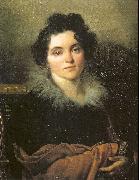 |
Kiprensky, Orest
|
|
Russian Painter, 1782-1836
Russian painter and draughtsman. The leading Russian portrait painter of the Romantic period, he was the illegitimate son of the landowner A. D'yakonov and was adopted by his serf, Adam Shval'b and granted his freedom at birth. His surname is unconnected with that of either his real or his adoptive father, and its origin is uncertain. In 1798 he was sent to the St Petersburg Academy of Arts, eventually studying history painting under Gabriel-Francois Doyen and Grigory Ugryumov. In 1805 he received an important gold medal for his painting Dmitry Donskoy on the Field of Kulikovo (St Petersburg, Rus. Mus.) and won the right to travel to Italy on a scholarship. He did not, however, do so immediately, because of the tense political situation in Europe. Kiprensky's history painting was in keeping with the patriotic mood of Russian society during the years of the war against Napoleon.
|
|
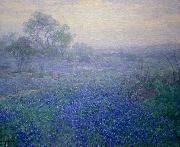 |
Julian Onderdonk
|
|
(July 30, 1882 - October 27, 1922) was a Texan Impressionist painter, often called "the father of Texas painting."
Julian Onderdonk was born in San Antonio, Texas, to Robert Jenkins Onderdonk, a painter, and Emily Gould Onderdonk. He was raised in South Texas and was an enthusiastic sketcher and painter. As a teenager Onderdonk was influenced and received some training from the prominent Texas artist Verner Moore White who also lived in San Antonio at the time. He attended the West Texas Military Academy, graduating in 1900.
At 19, with the help of a generous neighbor, Julian left Texas in order to study with the renowned American Impressionist William Merritt Chase. Julian's father, Robert, has also once studied with Chase. Julian spent the summer of 1901 on Long Island at Chase's Shinnecock School of Art. He studied with Chase for a couple of years and then moved to New York City to attempt to make a living as an en plein air artist. While in New York he met and married Gertrude Shipman and they soon had a son.
Onderdonk returned to San Antonio in 1909, where he produced his best work. His most popular subjects were bluebonnet landscapes. Onderdonk died on October 27, 1922 in San Antonio.
President George W. Bush decorated the Oval Office with three of Onderdonk's paintings. The Dallas Museum of Art has several rooms dedicated exclusively to Onderdonk's work.
|
|
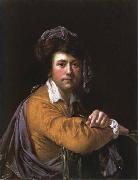 |
Joseph wright of derby
|
|
1734-97
English painter. He painted portraits, landscapes and subjects from literature, but his most original and enduringly celebrated works are a few which reflect the philosophical and technological preoccupations of the later 18th century and are characterized by striking effects of artificial light. He was the first major English painter to work outside the capital all his life: apart from spells in Liverpool (1768-71), Italy (1773-5) and Bath (1775-7), he lived and worked in his native Derby, though exhibiting in London at both the Society of Artists (1765-76, 1791) and the Royal Academy (1778-82, 1789-90, 1794).
|
|
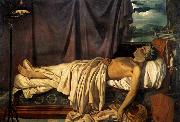 |
Joseph Denis Odevaere
|
|
1778-1830,Flemish painter. He attended evening classes at the Bruges Academie in 1794-5 and then went to Paris, where he entered the studio of the Bruges artist Joseph-Benoet Suvee. In 1801 he began training under Jacques-Louis David and in 1804 won the Prix de Rome for his Death of Phocion (Paris, Ecole N. Sup. B.-A.), in which he faithfully adhered to the principles of David's teaching. Before going to Italy he spent a year in Bruges carrying out portrait commissions, including the Marquis de Chauvelin (1805; Bruges, Groeningemus.). During his time in Rome (1805-12) he copied antique and Renaissance works, taking a particular interest in Raphael, who features in his wash drawing the Master of Urbino Introduced by Bramante to Julius II (1807; Bruges, Groeningemus.), a study for a lost painting. Around 1811 he was among the artists chosen to decorate the Palazzo del Quirinale for Napoleon's visit, although he never executed more than a sketch, Tanaquil Predicting the Future Greatness of Servius Tullius (c. 1811-12; Dijon, Mus. Magnin). Odevaere successfully exhibited in Paris in 1812 and then moved to Ghent, showing works at the Salon there two years later. After the union of the Low Countries in 1815 he became official painter to William I. As a result of this post he executed several works illustrating the history of the Dutch royal family, including the Prince of Orange Wounded at Waterloo (1817) and the Battle of Nieuwpoort (1820; both Brussels, Pal. Nation, on dep. Brussels, Pal. Justice). In 1815 he was commissioned to recover works of art taken from the Low Countries by the French. David's arrival in Brussels in 1816 coincided with the beginning of Odevaere's most ambitious composition, the Departure of the Athenians for Salamis (1816-25; Brussels, Mus. A. Anc.), inspired as much by Jean-Auguste-Dominique Ingres as by David, although the latter frequently advised Odevaere on the painting. From 1825 to 1829 he worked on a series of paintings conveying his support of the philhellenic committees created during the Greek War of Independence.
|
|
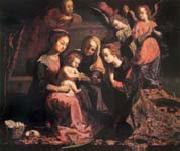 |
Josefa of Ayala
|
|
1630-1684,Portuguese painter and engraver. She was the daughter of the Portuguese painter Baltazar Gomes Figueira (1597-1674) and a Spanish lady, Doea Catarina de Ayala y Cabrera. After the restoration of the Portuguese monarchy in 1640 the family moved to Coimbra. Here Josefa began her apprenticeship under her father, a painter of landscapes, still-lifes and religious works, who in 1644 painted the retable of Nossa Senhora da Graea, Coimbra, in the naturalist-tenebrist style he had learnt in Seville in the circles of Juan del Castillo,
|
|
|
|
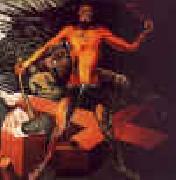 |
Jose Clemente Orozco
|
|
Mexican
1883-1949
Jose Clemente Orozco Gallery
Jose Clemente Orozco (November 23, 1883 ?C September 7, 1949) was a Mexican social realist painter, who specialized in bold murals that established the Mexican Mural Renaissance together with murals by Diego Rivera, David Siqueiros, and others. Orozco was the most complex of the Mexican muralists, fond of the theme of human suffering, but less realistic and more fascinated by machines than Rivera. Mostly influenced by Symbolism, he was also a genre painter and lithographer. Between 1922 and 1948, Orozco painted murals in Mexico City, Orizaba, Claremont, California, New York City, Hanover, New Hampshire, Guadalajara, Jalisco, and Jiquilpan, Michoac??n. His drawings and paintings are exhibited by the Carrillo Gil Museum in Mexico City, and the Orozco Workshop-Museum in Guadalajara.
Jos?? Clemente Orozco was born in Zapotl??n el Grande (now Ciudad Guzm??n), Jalisco to Rosa de Flores Orozco. He married Margarita Valladares, and had three children. In a childhood accident, Orozco lost his left hand while playing with gunpowder.
Jos?? Guadalupe Posada, a satirical illustrator whose engravings about Mexican culture and politics challenged Mexicans to think differently about post-revolutionary Mexico, worked in full view of the public in shop windows located on the way Orozco went to school. In his autobiography, Orozco confesses, "I would stop [on my way to and from school] and spend a few enchanted minutes in watching [Posada]?? This was the push that first set my imagination in motion and impelled me to cover paper with my earliest little figures; this was my awakening to the existence of the art of painting." (Orozco, 1962) He goes to say that watching Posado's engraving decorated gave him his introduction to the use of color. After attending school for Agriculture and Architecture, Orozco studied art at the San Carlos Academy.
With Diego Rivera, he was a leader of the artist movement known as Mexican Muralism. An important distinction he had from Rivera was his critical view of the Mexican Revolution. While Diego was a bold, optimistic figure, touting the glory of the revolution, Orozco was less comfortable with the bloody toll the social movement was taking. Orozco is known as one of the "Big Three" muralists along with Diego Rivera and David Alfaro Siqueiros. All three artists, as well as the painter Rufino Tamayo, experimented with fresco on large walls, and elevated the art of the mural.
|
|
|
|
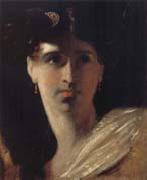 |
John Opie
|
|
English Painter, 1761-1807,English painter. He was born in a tin-mining district, where his father was a mine carpenter. He had a natural talent for drawing and was taken up by an itinerant doctor, John Wolcot (the poet Peter Pindar, 1738-1819), who was an amateur artist and had a number of well-connected friends. Wolcot taught Opie the rudiments of drawing and painting, providing engravings for him to copy and gaining him access to country-house collections. Opie's early portraits, such as Dolly Pentreath (1777; St Michael's Mount, Cornwall, Lord St Levan priv. col.), are the work of a competent provincial painter and owe much to his study of engravings after portraits by Rembrandt. His attempts at chiaroscuro and impasto in Rembrandt's manner gave his pictures a maturity that clearly startled contemporary audiences expecting to see works by an untutored artist. Thus in 1780, when a picture by him was exhibited in London at the Society of Artists with the description 'a Boy's Head, an Instance of Genius, not having ever seen a picture', Opie was hailed as 'the Cornish Wonder'. When he himself arrived in London, where he was promoted by Wolcot and his paintings were exhibited at the Royal Academy in 1781 and 1782, he was seen as a phenomenon, impressing even Joshua Reynolds, who is reputed to have remarked that Opie was 'like Caravaggio and Velasquez in one'.
|
|
|
|
|
|
|
|
|
|
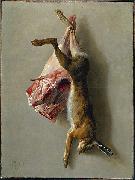 |
Jean-Baptiste Oudry
|
|
(17 March 1686 - 30 April 1755) was a French Rococo painter, engraver, and tapestry designer. He is particularly well known for his naturalistic pictures of animals and his hunt pieces depicting game.
Jean-Baptiste Oudry was born in Paris, the son of Jacques Oudry, a painter and art dealer, and of his wife Nicole Papillon, who belonged to the family of the engraver Jean-Baptiste-Michel Papillon.
His father was a director of the Academie de St-Luc art school, which Oudry joined. At first, Oudry concentrated on portraiture, and he became a pupil and perhaps a collaborator of Nicolas de Largilliere from 1707 to 1712. He graduated at only 22 years of age, on 21 May 1708, at the same time as his two older brothers. The next year, he married Marie-Marguerite Froisse,[1] the daughter of a miroitier (a mirror-maker) to whom he gave lessons in painting.
Oudry became an assistant professor at Academie de Saint-Luc in 1714, and professor on 1 July 1717. He was inducted as a member of the prestigious Academie Royale de Peinture et de Sculpture in 1719, and was engaged as a professor there in 1743.
After producing mainly portraits, Oudry started to produce still life paintings of fruits or animals, aa well as paintings of religious subjects, such as the Nativity, Saint Giles, and the Adoration of the Magi.
|
|
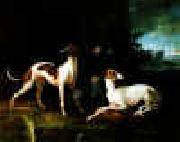 |
Jean Baptiste Oudry
|
|
French Baroque Era Painter, 1686-1755
French painter. He was the principal animal painter and one of the foremost decorative painters during the first half of Louis XVs reign. After initial training as a portrait painter, he concentrated on still-lifes; by the 1720s he had also begun to establish himself as a specialist in hunting scenes, game-pieces and portraits of animals. He ran an active workshop, often keeping his best originals for years and selling copies and (more or less autograph) variants. In the 1730s he was most active as a tapestry designer, making numerous designs for the royal tapestry works of Beauvais and the Gobelins, and he continued to produce his brilliantly painted hunts, still-lifes and studies of animals and birds to the end of his career.
|
|
|
|
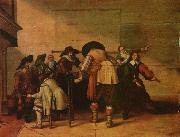 |
Jan Olis
|
|
painted Frohliche Gesellschaft in 1644
|
|
|
|
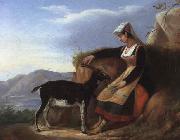 |
Jacques-Francois Ochard
|
|
was a French artist, remembered as the first art teacher of Claude Monet at his high school.
Ochard had been a student of Jacques-Louis David (1748-1825), and lived in Normandy, to where Monet's family had moved in 1845. Ochard's method of instruction was the traditional one of drawing from plaster casts of the human figure.
|
|
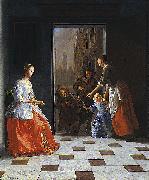 |
Jacob Ochtervelt
|
|
(1634, Rotterdam - 1682, Amsterdam), was a Dutch Golden Age painter.
According to the RKD he was active in Haarlem where he was a student of Nicolaes Pietersz Berchem and later he moved back to Rotterdam (1655-1672) where he was a pupil of Ludolf de Jongh. After the rampjaar he moved to Amsterdam
|
|
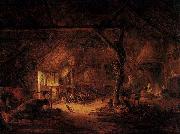 |
Isaac van Ostade
|
|
(bapt. June 2, 1621, Haarlem - buried October 16, 1649, Haarlem) was a Dutch genre and landscape painter.
Van Ostade began his studies under his brother, Adriaen, with whom he remained till 1641, when he started his own practice. At an early period he felt the influence of Rembrandt, and this is apparent in a Slaughtered Pig of 1639, in the gallery of Augsburg. He soon found a style more suited to his own inclinations. He produced pictures in 1641-1642 on the lines of his brother - amongst these, the Five Senses, which Adrian afterwards represented by a Man reading a Paper, a Peasant tasting Beer, a Rustic smearing his Sores with Ointment and a Countryman sniffing at a Snuff-box. A specimen of Isaac's work at this period may be seen in the Laughing Boor with a Pot of Beer, in the museum of Amsterdam; the cottage interior, with two peasants and three children near a fire, in the Berlin museum; a Concert, with people listening to singers accompanied by a piper and flute player, and a Boor stealing a Kiss from a Woman, in the Lacaze collection at the Louvre.
The interior at Berlin is lighted from a casement in the same Rembrandtesque style as Adrian's interior of 1643 at the Louvre. He received low prices for this kind of painting, in which he could only remain subordinate to his brother. Gradually he abandoned Adrian's cottage subjects for landscapes in the fashion of Esaias van de Velde and Salomon van Ruysdael. Once only, in 1645, he reverted to the earlier mode, when he produced the Slaughtered Pig, with a boy puffing out a bladder, in the museum of Lille.
Isaac's progress in his new path was greatly facilitated by his previous experience as a figure painter; and, although he now selected his subjects either from village high streets or frozen canals, he gave fresh life to the scenes by depicting animated groups of people with a refined and searching study of picturesque contrasts. He did not live long enough to bring his art to the highest perfection. He died on 16 October 1649 having painted about 400 pictures (see H de Groot, 1910).
The first manifestation of Isaac's surrender of Adrian's style is apparent in 1644 when the skating and sledging scenes were executed which we see in the Lacaze collection and the galleries of the Hermitage, Antwerp and Lille. Three of these examples bear the artists name, spelled Isack van Ostade, and the dates of 1644 and 1645. The roadside inns, with halts of travellers, form a compact series from 1646 to 1649. This is the last form of Isaac's art and has very distinct peculiarities. The air which pervades his composition is warm and sunny, yet mellow and hazy, as if the sky were veiled with a vapour coloured by moor smoke. The trees are rubbings of umber, in which the prominent foliage is tipped with touches hardened in a liquid state by amber varnish mediums. The same principle applied to details such asglazed bricks or rents in the mud lining of cottages gives an unreal and conventional stamp to them.
These quirks are overcome by his broad contrasts of light and shade and the masterly figures of horses, riders, travellers, rustics, quarrelling children, dogs, poultry and cattle. A favorite place is always given to the white horse, which seems as invariable an accompaniment as the grey in the skirmishes and fairs of Philip Wouwerman.
Isaac displays the best qualities in winter scenes. The absence of foliage, the crisp atmosphere and the calm air of cold January days, unsullied by smoke or vapour, preclude the use of the brown tinge, and leave the painter no choice but to ring the changes with a great variety of opal tints. Then the figures emerge with masterly effect on the light background. Amongst the roadside inns it is worth noting those in the collections of Buckingham Palace, the National Gallery, London, the Wallace Collection and Holford collections in England, the Louvre, Berlin, Hermitage and Rotterdam museums and the Rothschild collection at Vienna. The finest of the ice scenes is the famous one at the Louvre.
|
|
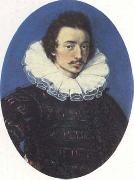 |
Isaac Oliver
|
|
French-born English Miniaturist, ca.1560-1617
was a French-born English portrait miniature painter. Born in Rouen, he moved to London in 1568 with his Huguenot parents Peter and Epiphany Oliver to escape the Wars of Religion in France. He then studied miniature painting under Nicholas Hilliard; and developed a naturalistic style, which was largely influenced by Italian and Flemish art. He later married Sara, daughter of the well-known portrait painter Marcus Gheeraerts the Elder (c. 1520 ?C c. 1590) and his wife Susannah de Critz in 1602 after his first wife, Elizabeth, had died in 1599 ?C the mother of his eldest child: Peter Oliver, who was also a famous "limner". Susannah was the daughter of Troilus de Critz, a goldsmith from Antwerp, and close relative of John de Critz, the Queen's Serjeant-Painter. She was also the older sister or cousin of Magdalen de Critz who married Marcus Gheeraerts the Younger (1562 ?C 1635). After the death of Elizabeth I, he became a painter of James I's court,
|
|
 |
Ilya Ostroukhov
|
|
1858-1929. Was a Russian painter. Ostroukhov was born to a rich family. In 1885, Ostroukhov joined the Association of Travelling Art Exhibitions. Ostroukhov was primarily a landscape painter.
|
|
|
|
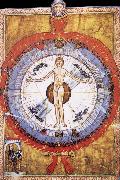 |
Hildegard of Bingen
|
|
1098-1179,German composer, abbess and mystic. Her writings include much lyrical and dramatic poetry which has survived with monophonic music. The Symphonia armonie celestium revelationum contains musical settings of 77 poems arranged according to the liturgical calendar. The poetry is laden with imagery and the music, based on a few formulaic melodic patterns, is in some respects highly individual. Her morality play Ordo virtutum contains 82 melodies in a more syllabic style.
|
|
|
|
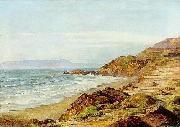 |
Henry Otto Wix
|
|
Henry Otto Wix (1866 - 1922), also known as Otto Wix, was a German-born landscape and portrait painter who emigrated to the United States in the late 1890s. He studied in New York, but visited Hawaii in 1907 and 1908-9. About 1910, he moved to San Francisco, but visited Hawaii again in 1912. He also made several sketching trips to Mexico. Wixes marriage ended in divorce, resulting in depression and alcoholism. He died by his own hand in Santa Barbara, California on March 13, 1922.
Wix is best known for his landscapes in watercolor. The Honolulu Academy of Arts and the Smithsonian American Art Museum are among the public collections holding paintings by Henry Otto Wix
|
|
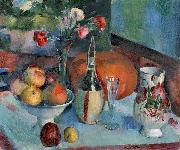 |
Henry Ottmann
|
|
painted Nature morte aux fruits et a la fiasque de vin in 20th century
French, 1877-1927
|
|
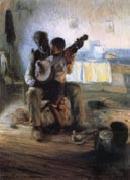 |
Henry Ossawa Tanner
|
|
African-American Realist Painter, 1859-1937
American painter. He was one of the foremost African American artists, achieving an international reputation in the early years of the 20th century for his religious paintings. The son of an African Methodist Episcopal bishop, he studied art with Thomas Eakins from 1880 to 1882 at the Pennsylvania Academy of the Fine Arts in Philadelphia. He then worked in Philadelphia and Atlanta, GA, where he ran a photography studio and taught at Clark College.
|
|
|
|
|
|
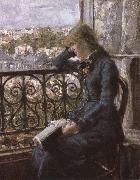 |
Hans Olaf Heyerdahl
|
|
Swedish, 1857-1913
Norwegian painter. He was born into an enlightened but conservative family, his father being an engineer, occasional architect and writer of Nordic saga poetry, and he spent his childhood and youth in the rapidly expanding town of Drammen, 40 km from the capital Christiania. In 1873 he was admitted to the Kongelige Tegneskole in Christiania, where he studied under Peder C. Thurmann, a landscape artist trained in Desseldorf. For more advanced training, Heyerdahl was obliged to go abroad, and in 1874 he enrolled at the Munich Akademie. He was encouraged by Professor Ludwig von Lefftz (1845-1910) to give up landscape in favour of history painting and portraits (e.g. the artists Christian Skredsvig, 1876, and Eilif Peterssen, 1877; both Oslo, N.G.). In 1877, under the guidance of Professor Wilhelm Lindenschmit (1829-95), Heyerdahl finished his most inventive and brilliant composition, the Expulsion from the Garden (Oslo, N.G.). Using over life-size figures, set in a barren tempestuous landscape, Heyerdahl skilfully contrasted the youthful rage of Adam with the resigned despair of Eve. This sombre work won him a third prize medal at the Exposition Universelle in Paris in 1878.
|
|
|
|
|
|
|
|
|
|
|
|
|
|
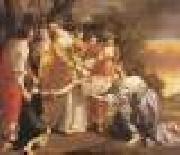 |
GENTILESCHI, Orazio
|
|
Italian Baroque Era Painter, ca.1563-1639
Although he was eight years older than Caravaggio, he is nevertheless regarded as a Caravaggesque artist, so deeply was his mature style affected by his knowledge of the younger painter's art. His response to Caravaggio was intensely poetic, and none of Caravaggio's many gifted followers produced more beautiful pictures.
|
|
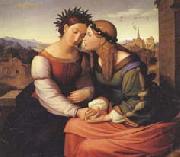 |
Friedrich overbeck
|
|
1789-1869
German religious painter. Expelled from the Vienna Academy because of his opposition to its classicism, he went to Rome and with Peter von Cornelius, Veit, Schadow-Godenhaus, and others, formed the group known as the Nazarenes. His first real successes were his frescoes for the Casa Bartholdy (now in Berlin) and for the Villa Massimo. Among his notable paintings are Christ's Entry into Jerusalem and Christ's Agony in the Garden. Overbeck sought to make his art serve religion.
|
|
|
|
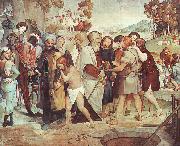 |
Friedrich Johann Overbeck
|
|
1789-1869
German
German religious painter. Expelled from the Vienna Academy because of his opposition to its classicism, he went to Rome and with Peter von Cornelius, Veit, Schadow-Godenhaus, and others, formed the group known as the Nazarenes. His first real successes were his frescoes for the Casa Bartholdy (now in Berlin) and for the Villa Massimo. Among his notable paintings are Christ Entry into Jerusalem and Christ Agony in the Garden. Overbeck sought to make his art serve religion. His influence was due more to the purity of his doctrine than to the power of his work, which is often lacking in pictorial appeal and in color.
|
|
|
|
|
|
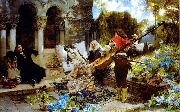 |
Francisco Pradilla Ortiz
|
|
(July 24, 1848 - November 1, 1921) was a prolific Spanish painter famous for creating historical scenes.
He was born in Villanueva de Gellego, near Zaragoza in Aragon, and studied initially in Zaragoza and then transferred to the Real Academia de Bellas Artes de San Fernando and the Academia de Acuarelistas in Madrid. In 1873, he won a scholarship to go to Rome. From there he had opportunities to travel to France and Venice and studied the old masters. In 1878 he submitted his painting Doña Joanna of Castile or (Juana la Loca) to the National Exhibition in Spain and was awarded the Medal of Honor. The Spanish Senate then commissioned him to create La Rendicien de Granada (The Surrender of Granada) that took him three years to complete (1882). In 1881 he became the Director of the Spanish Arts Academy in Rome, but resigned from this post after two years. He traveled, mostly in Italy, portraying local themes and people. In 1897 he returned to Madrid as the director of the Museo del Prado. He held this position only briefly and then focused again on painting.
His total output is well over 1,000 paintings showing his interest in a variety of subjects and styles, often without regard of the current fashion. He is primarily recognized for his historical paintings, the last one completed in 1910 carries one of the longer titles of a major painting, Cortejo del bautizo del Prencipe Don Juan, hijo de los Reyes Catelicos, por las calles de Sevilla (Retinue of the Baptism of Don Juan, son of the Catholic Monarchs, Along the Streets of Seville). Much more common, however, are costumbristaseoften romanticized studies that show local customs or mannerseand landscapes that are often sketchy, with impressionistic influences. Financial duress after the bankruptcy of his bank may have imposed a special need to be productive.
He died in Madrid in 1921 at the age of 73.
|
|
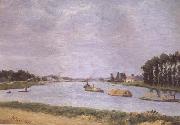 |
Francisco Oller y Cestero
|
|
San Juan,Puerto Rico 1833-Santurce 1917
Puerto Rican painter. He studied from 1851 to 1853 at the Real Academia de Bellas Artes de San Fernando in Madrid under Federico de Madrazo y Kentz and in Paris from 1858 to 1863 under Thomas Couture and Charles Gleyre at the Ecole Imperiale et Speciale de Dessin and at the Academie Suisse. There he met Camille Pissarro, Paul Cezanne and Armand Guillaumin, who together with Couture and the work of Courbet influenced his work towards Realism and Impressionism.
|
|
|
|
|
|
|
|
|
|
|
|
|
|
|
| Wholesale China Oil Painting Wholesale Oil Painting China Xiamen Portrait Reproduction on canvas Chinese Oil Painting Wholesale USA Oil Painting |
|
|
|
|
|